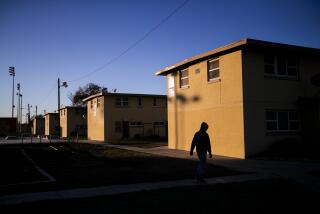Tour Shows Watts as a Place of Culture, Art
Beneath a broiling sun, busloads of tourists from throughout Southern California on Saturday discovered one of L.A.’s most exotic communities: Watts.
The neighborhood southeast of downtown Los Angeles may lack the glitz of Rodeo Drive, the verve of Hollywood and Vine or the vibes of Venice Beach.
But now activists are embarking on a campaign to attract visitors to what they say is one of Los Angeles’ most vibrant communities, a place that for too long has been avoided.
They are determined to persuade people to think differently about Watts. Their campaign theme: “Watts Is L.A.!”
Sites seen on a series of bus tours included shopping centers, schools, a rose garden and King-Drew Medical Center, built after the 1965 riots that continue to mark the community.
The highlight was the Watts Towers, the enigmatic creation of the late Simon Rodia, an Italian immigrant and itinerant tile-setter who labored for more than 30 years on the chimerical project.
It says something about Watts that it has achieved worldwide name recognition through a riot--and a work of art.
Tour leaders deliberately stressed a vision that transcends Watts’ image as “a place of unbridled anger and desperation,” in the words of a brochure provided to Saturday’s visitors.
Sponsors hope to bring investment to Watts and elsewhere in South-Central Los Angeles, a region largely bypassed by the wealth of merchandise that travels on freeways and rail throughout the region. The heavily industrialized Alameda Corridor, connecting the harbor to downtown Los Angeles, stands at the eastern border of Watts.
“We’re a bypassed community,” said Janine Watkins, one of the organizers and the daughter-in-law of the late Ted Watkins, a longtime community activist who had a park named after him. “Tourism to L.A. shouldn’t be just about Disneyland and Universal City.”
In the organizers’ eyes, blue-collar Watts is among Los Angeles’ most historically significant neighborhoods. Since early in the century, the narrow, flat expanse of land near the county’s geographic center has provided homes for generations of residents striving to improve their lot.
The neighborhood “hall of fame” boasts an eclectic mix, including Florence Griffith-Joyner, the late track and field star; Glenn Seaborg, the Nobel Prize-winning scientist and co-discoverer of plutonium; and Ivori Toguri, a Watts-reared Japanese American who achieved World War II radio fame as “Tokyo Rose.”
First-time visitors are often surprised to see that Watts is far from the war zone that has been portrayed in news accounts of gang shootings, fires and other troubles.
“I felt at home,” said Jan Baird, a schoolteacher who took the free tour. “I thought it was fabulous.’
Baird said she was doing her morning exercises at home in Mar Vista when she read about the bus tour and decided to drive over. Like many other participants, she had only a general notion of where Watts is.
Today, Watts is a focal point for immigrants from Mexico and Central America who, along with their children, comprise at least half the population. African Americans, who first arrived from the rural South early in the century, account for much of the other half.
The first tour vehicle, a yellow school bus carrying about 50 visitors, departed shortly after 10 a.m. from the parking lot of the Watts Labor Community Action Committee, a nonprofit group that is sponsoring the weekly tours. A grant from the California Council for the Humanities helped finance the event.
Janine Watkins acted as tour guide, raising her voice over the bus’s roaring engine.
Among those on board was Ken Phillips, a retired aerospace engineer from Chatsworth, and his wife, Shirley Raymond. “I know I’m going to be impressed,” Phillips said as he sat in the bus. He wasn’t disappointed.
The bus first pulled by Verbum Dei High School, a Catholic school that, Watkins told the riders, continues to provide a first-rate education for area youths.
A short time later, the bus chugged past the Nickerson Gardens low-income housing project, on this morning a quiet tableau of children playing on the grass and adults sweeping their steps and getting ready for weekend barbecues.
Other destinations included the 80-year-old Grant AME Church, a street of typical 1920s working class bungalows, Watts’ former City Hall (the neighborhood became part of Los Angeles in 1927), and its historic train station.
The community’s artistic heritage took many by surprise. Visitors were told of galleries, music festivals, concerts and other events.
The only extended stop was at Rodia’s personal fantasia, its pointed spires reminiscent of Gothic cathedrals and the minarets of mosques. The scaffolding of ongoing reconstruction marred the view, but tour-goers were nonetheless impressed.
“It’s just incredible that one man could be so driven,” said Sheri Rycus-Weston, a visual effects worker from Studio City who came with her two children, Kaleigh, 6, and Zane, 5. “I’m so impressed by the passion the man had. I wish I could be so driven in my work.”
At the Watts Towers Arts Centers, the tourists saw a brief film that featured Rodia visiting his creation. “I had it in my mind to do something big, and I did,” the artist explained.
As the tour ended, participants seemed pleasantly surprised by the obvious vitality they saw.
“Their gardens and lawns seemed a lot better than many of ours in Long Beach,” said Annette Alender, a retired schoolteacher. “They have pride in their area.”
More to Read
Sign up for The Wild
We’ll help you find the best places to hike, bike and run, as well as the perfect silent spots for meditation and yoga.
You may occasionally receive promotional content from the Los Angeles Times.






